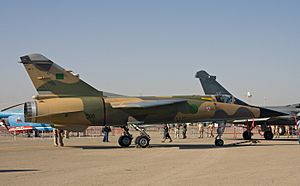2011 Libyan civil war facts for kids
Quick facts for kids Libyan Civil War |
|||||
|---|---|---|---|---|---|
| Part of Arab Spring | |||||
   |
|||||
|
|||||
| Belligerents | |||||
Anti-Gaddafi tribes UN member states enforcing UNSC Resolution 1973: full list
|
Libya
|
||||
| Commanders and leaders | |||||
|
|
|||||
| Strength | |||||
|
Approximately 17,000 volunteers by Mar 24 (1,000 trained men by Mar 23) International Forces: Numerous air and maritime forces (see here) |
10,000–20,000+ soldiers, unknown number of militia | ||||
| Casualties and losses | |||||
|
2,098-2,834 opposition fighters, activists and supporters killed (see Casualties of the 2011 Libyan civil war) |
1,044-1,132 soldiers killed (see Casualties of the 2011 Libyan civil war), 200 captured | ||||
| Estimated total killed on both sides including civilians: 10,000 |
|||||
The Libyan Civil War was a conflict in Libya in 2011. It started in February 2011. Many Libyans were inspired by protests in nearby countries. They protested against their government.
Colonel Muammar Gaddafi, the leader, sent soldiers to stop the protests. Rebels formed their own government. The war ended in October with Gaddafi's death. Thousands of people died during the conflict.
How the Protests Began
The conflict started with many demonstrations and riots. Small protests happened in January. Bigger protests began on February 14, 2011. People were protesting against the Libyan government and its leader, Muammar Gaddafi.
Thousands joined the protests. Gaddafi promised to find and remove all rebels. But some of Gaddafi's soldiers joined the rebels. The protests were inspired by successful uprisings in Tunisia and Egypt.
A reporter named Richard Engel entered Libya in February 2011. He said the protests had become a war. The Economist newspaper called it an uprising. It aimed to free Libya from its long-time ruler.
On February 21, the Libyan Air Force attacked civilians in Tripoli. This caused many countries to speak out against Libya. By this time, hundreds of people had died. Thousands more were injured.
Fighting Begins
Small battles took place until February 24. On that day, Gaddafi sent tanks and troops into Misrata. They attacked the city. Then, on March 6, Gaddafi's forces launched a counter-attack. This lasted until March 12. They took back cities like Ra's Lanuf and Brega.
The rebels gained strength when NATO and other countries helped. They started bombarding Gaddafi's forces. This was done using attack aircraft.
The rebels launched their own counter-attack on March 27. It lasted until April 1. The rebels were able to take back some cities.
The Battle of Misrata was a very fierce fight. Gaddafi's Hamza Brigade fought the rebels there. This was from February 24 to March 12. Gaddafi's son, Khamis, led the Khamis Brigade. They nearly destroyed the whole city. But the rebels won the battle. They took control of Misrata.
The War Ends
The rebels also won battles in Benghazi and other areas. They took control of Tripoli in August. By October, the fighting lessened. The rebels then declared their victory.
Images for kids
-
Graffiti in Benghazi, showing a connection to the Arab Spring.
-
A young person in Benghazi carries a photo of (deposed) King Idris.
-
President Barack Obama speaks about the military action in Libya.
See also
 In Spanish: Guerra de Libia de 2011 para niños
In Spanish: Guerra de Libia de 2011 para niños

















